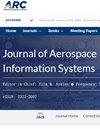Model-Free Ground Velocity and Position Estimation for Manned and Unmanned Aircraft
IF 1.5
4区 工程技术
Q2 ENGINEERING, AEROSPACE
引用次数: 0
Abstract
Navigation is a critical task for the operations of both manned and unmanned aircraft systems. Current positioning systems rely primarily on satellite systems such as the Global Positioning System (GPS) or alternative sensor fusion algorithms, which typically require vision sensing and processing. Due to the possibility of temporary GPS outages and/or GPS jamming, it is critical for aircraft sensing systems to predict the position as well as the ground velocity of the aircraft in the absence of GPS signals. This work proposes two state estimation algorithms for predicting the position and ground velocity of aircraft. These methods do not require vision sensors or aircraft dynamic model information, thus providing a portable approach applicable to any aircraft. The proposed methods consider infrequent GPS position updates. Although not completely GPS free, these algorithms do not require GPS velocity measurements and can predict the aircraft position in between the position updates. The proposed methods use the information filter and unscented information filter; they are first validated using unmanned aircraft flight data and later applied to flight data from a high-speed manned military trainer jet. The results indicate the effectiveness of this approach for model-free position and ground velocity estimation.载人和无人飞行器的无模型地面速度和位置估计
导航是载人和无人飞机系统运行的关键任务。目前的定位系统主要依赖于卫星系统,如全球定位系统(GPS)或替代传感器融合算法,这通常需要视觉感知和处理。由于GPS暂时中断和/或GPS干扰的可能性,在没有GPS信号的情况下,飞机传感系统预测飞机的位置和地面速度是至关重要的。本文提出了两种状态估计算法来预测飞行器的位置和地面速度。这些方法不需要视觉传感器或飞机动态模型信息,因此提供了一种适用于任何飞机的便携式方法。所提出的方法考虑了不频繁的GPS位置更新。虽然不是完全没有GPS,但这些算法不需要GPS速度测量,并且可以在位置更新之间预测飞机位置。该方法采用了信息过滤器和无气味信息过滤器;它们首先使用无人驾驶飞机飞行数据进行验证,随后应用于高速有人驾驶军用教练机的飞行数据。结果表明,该方法对无模型位置和地面速度估计是有效的。
本文章由计算机程序翻译,如有差异,请以英文原文为准。
求助全文
约1分钟内获得全文
求助全文
来源期刊

Journal of Aerospace Information Systems
ENGINEERING, AEROSPACE-
CiteScore
3.70
自引率
13.30%
发文量
58
审稿时长
>12 weeks
期刊介绍:
This Journal is devoted to the dissemination of original archival research papers describing new theoretical developments, novel applications, and case studies regarding advances in aerospace computing, information, and networks and communication systems that address aerospace-specific issues. Issues related to signal processing, electromagnetics, antenna theory, and the basic networking hardware transmission technologies of a network are not within the scope of this journal. Topics include aerospace systems and software engineering; verification and validation of embedded systems; the field known as ‘big data,’ data analytics, machine learning, and knowledge management for aerospace systems; human-automation interaction and systems health management for aerospace systems. Applications of autonomous systems, systems engineering principles, and safety and mission assurance are of particular interest. The Journal also features Technical Notes that discuss particular technical innovations or applications in the topics described above. Papers are also sought that rigorously review the results of recent research developments. In addition to original research papers and reviews, the journal publishes articles that review books, conferences, social media, and new educational modes applicable to the scope of the Journal.
 求助内容:
求助内容: 应助结果提醒方式:
应助结果提醒方式:


